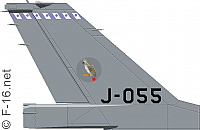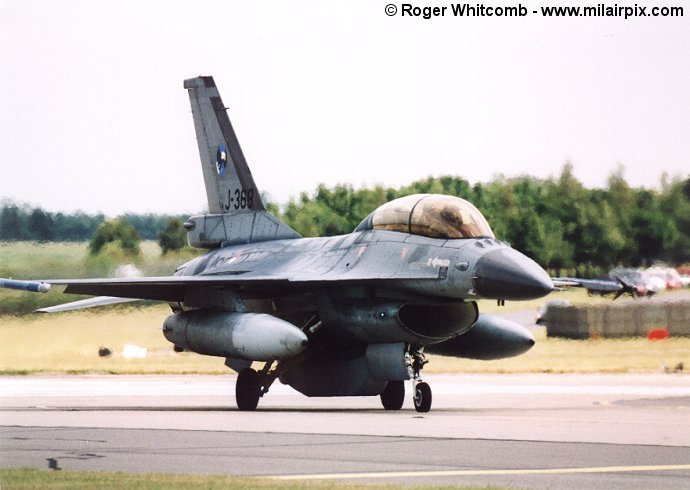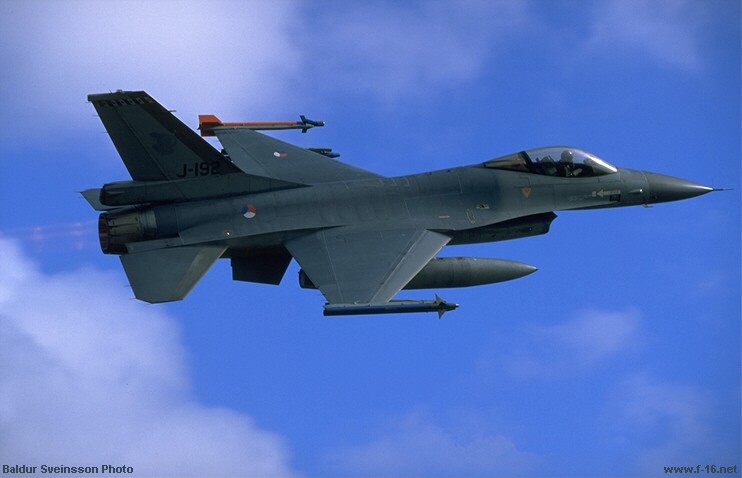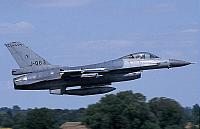 |
The Netherlands
Koninklijke Luchtmacht
|
Introduction
The Royal Netherlands Air Force purchased a total of 213 F-16A/B aircraft. The Netherlands were one of the four European Participating Air Forces, and one of 5 countries to build the F-16 locally. Force reductions saw the fleet reduced to 68 aircraft, all of them upgraded to MLU standard. Some surplus aircraft have been sold to Jordan and Chile.
Inventory
Initial Order
The Netherlands was one of the four initial European NATO customers for the F-16, along with Belgium, Denmark, and Norway. The initial Dutch order for F-16A/B aircraft was for 102 examples (80 single-seat F-16A's and 22 two-seat F-16B's), which were to be assembled at Fokker. This line first opened up for business in April of 1978, and was the second of the European F-16 final assembly lines to open, SABCA in Belgium being the first. The first Dutch built F-16 took off on its maiden flight on May 3rd, 1979, with test pilot Henk Temmen at the controls. Initial delivery of the F-16A/B to the KLu took place in June of 1979.
Follow-On Order
In March of 1980, the Netherlands announced plans (finally approved by the Dutch Parliament in December 1983) to buy an additional 111 aircraft (97 F-16A's and 14 F-16B's). This brought the total F-16 inventory to 213 aircraft, 177 A models and 36 B models. The last F-16 rolled off the line at Fokker's Schiphol plant on February 27th, 1992. It was #J-021 (#89-0021), and was the last of 213 examples delivered to the KLu.
Fleet Reduction
In 2003, the Dutch government decided to cut the F-16 force by 25%. From 2004 onwards, The Netherlands will provide 108 F-16s to NATO, with 90 being available for operational deployments. As many as 36 F-16s would be sold; however, increased attrition losses might reduce this number.
On November 21st, 2005 Jordan signed a LOI to buy three Dutch F-16s, all two-seaters. These aircraft #J-650, #J-653 and #J-654 will be delivered in 2009. All these F-16s have been modified with the MLU upgrade. ANother 3 two-seaters were added to the order in 2007.
In December of 2005 the Chilean government signed a contract with the Netherlands to supply it with up to 18 Dutch F-16s (11 Alpha models and 7 Bravo models). These will form a new squadron aside the newly delivered block 50 F-16s. Another lot was ordered in May of 2008 for delivery in 2010. These 18 F-16s are all A-models and will equip another Chilean squadron.
| Program | Model | Block | Qty. | Serials | Delivered |
|---|---|---|---|---|---|
| Initial Order | F-16A | block 1 | 12 | J-212/J-223 | 1979-1980 |
| F-16B | Block 1 | 6 | J-259/J-264 | 1979-1980 | |
| F-16A | block 5 | 14 | J-224/J-237 | 1980-1981 | |
| F-16B | Block 5 | 2 | J-265/J-266 | 1980-1981 | |
| F-16A | block 10 | 20 | J-238/J-257 | 1981-1982 | |
| F-16B | Block 10 | 5 | J-267/J-271 | 1981-1982 | |
| F-16A | Block 15 | 34 | J-258 J-616/J-648 |
1982-1984 | |
| F-16B | Block 15 | 9 | J-649/J-657 | 1982-1984 | |
| Follow-On Order | F-16A | Block 15 | 50 | J-864/J-881 J-192/J-207 J-358/J-367 J-135/J-140 |
1984-1987 |
| F-16B | Block 15 | 9 | J-882 J-884/J-885 J-208/J-211 J-368/J-369 |
1984-1987 | |
| F-16A | block 15OCU | 47 | J-141/J-146 J-054/J-063 J-508/J-516 J-710 J-001/J-021 |
1987-1992 | |
| F-16B | Block 15OCU | 5 | J-064/J-068 | 1988-1989 |
Modifications & Armament
Armament
In the interception role, KLu F-16s are equipped with AIM-9N, -9L, and -9M Sidewinder AAM's. AIM-120 AMRAAM missiles are used for longer-range interceptions. All F-16 units have Mk82/84 bombs and cluster weapons.
In 1997, the RNLAF awarded Hughes Missile Systems Company a contract for 36 AGM-65G missiles. During operations over former Yugoslavia, the RNLAF detachment in Italy leased AGM-65D missiles from the USAF, pending delivery of the AGM-65G.
312 squadron has a tactical nuclear commitment, carried out with US supplied nuclear weapons.
The RNlAF has also acquired LGBs (GBU-24, GBU-10, GBU-12, CBU-87), and will acquire AIM-9X and JDAM.
F-16(R) and Recce Pods
In 1983, F-16s from 306 sqn took over the Oldelft Orpheus camera pods which were previously carried by RF-104G Starfighters. The 306 sqn was selected since it was the RNlAF's designated recce unit. 18 F-16A's were modified to accomodate the Orpheus pod on the fuselage centerline station, and fitted with radar altimeter and a control box for the Oldelft Orpheus pod. Modified F-16s are designated F-16A(R). The F-16A(R) was first flown on January 27th, 1983. The Orpheus pod contains a camera and IR line-scanner equipment.
In 2002, 306 sqn lost its recce role, and replaced 313 sqn as the F-16 Theatre Operational Conversion unit. The recce role is now assigned to three frontline squadrons (311 sqn, 315 sqn, and 322 sqn). Since all MLUs are technically capable of carrying a recce pod, no modifications are required. The RNlAF now uses the Medium Altitude Reconnaissance System (MARS). MARS uses Reccon Optical cameras, mounted in a standard Per Udsen Modular Recconaissance pod. The first operational flight with the MARS pod was carried out on June 6th, 2000, by two F-16AMs of 315 Squadron (#J-136 and #J-145), although the pod was already inservice for testing purposes since 1997.

Mid-life Update
All operational F-16A/B's operated by the Netherlands went through the Mid-Life Update (MLU) by 2003. A Multinational Operational Test and Evaluation center for the F-16A/B Mid-Life Update was established at Leeuwarden air base during 1997. As part of continuing defense cuts, the number of KLu F-16s to undergo MLU was reduced from 170 to 138 in mid-1993.
Other
The Dutch Air Force has purchased a number of LANTIRN targeting systems, and has also agreed on the Joint Helmet-mounted Cueing System. The RNlAF has purchased 108 ALQ-131 pods for use on its F-16s. The ALQ-131 pods been upgrade to Block-2 configuration. In combination with the Lantirn targeting pod, 60 examples of the GEC/MARCONI navigation pods were acquired. However these are carried very rarely by Dutch F-16s. In 2006 an order was also placed for 8 Elbit Reccelite pods and Litening AT pods. These are to be delivered in 2008.
Operational Service
Units
Please refer to the F-16 Units section for an overview of units.Deployments
|
Joint Falcon / Allied Force Italy, 1999 In 1992, right after the start of the wars starting the demise of Yugoslavia, the Dutch government decided to send F-16 fighters to Italy to support the multi-national UN force that was stationed in Croatia and Bosnia-Herzegovina. The Dutch wanted to do this in cooperation with the Belgian Air Force to cut back on operational costs. At first the Belgian government was very reluctant to do this, because of major defense restructures going on at the time. After four years and a lot of negotiations later the Belgian government decided to take a look at it. Finally, in 1996, Belgium and The Netherlands signed a DATF (Deplayable Air Task Force) agreement. This made a joint deployment of fighters, but also of military transport aircraft, possible. Right after signing this agreement, the BAF joined the RNLAF at Villafranca AFB in Italy in the operation called 'Joint Falcon'. In a first stage the number of Dutch F-16s was limited to 8, but with the tension in the region rising, the total number rose to as much as 20 aircraft during operation 'Allied Force' in 1999. Just before the conflict started in March, the first MLU aircraft were sent over to Italy, which greatly expanded the possibilities of the DATF. The operation finally ended in 2001. On March 24th, 1999, a Dutch F-16 (#J-063), part of the Dutch-Belgian DATF based at Amendola AFB in Southern Italy, caught sight of a Serbian Mig-29 appearing on its radar screen. The pilot did not hesitate one moment and fired an AIM-120 missile towards the target. After a few seconds a kill was confirmed and the first Dutch kill after WWII was a fact. On April 4th, 1999, Dutch F-16s engaged ground targets with the AGM-65G, marking the first time this missile was fired in anger bij the RNlAF. |
|
|
Enduring Freedom Manas AB, Kyrgyzstan, 2002 In 2002 the Dutch government decided to send F-16s to Afghanistan in support of operation 'Enduring Freedom'. Their aircraft are stationed at Manas AFB in Kyrgyzstan together with aircraft from Denmark and Norway. Operations have been flown from October 2002 to October 2003. All EPAF countries, except for Belgium, have flown together in this operation. The RNlAF returned to Manas AB with 6 F-16s on September 10th, 2004. They deployed there to provide assistance to the NATO-led ISAF force during the Afghan presidential elections. The aircraft returned to the Netherlands on November 19th, 2004 and thus ended this short deployment. |
|
|
Baltic Republics Air Police Lithuania, 2004 In succession of Belgium, Denmark and Norway, the Dutch sent 4 F-16 fighters for patrolling the air of the three Baltic republics - Latvia, Lithuania and Estonia. From April 1st till June 30th, 2005 they provided air cover over the Baltic states. Together with this deployment, the Dutch also sent 4 F-16s to Manas AB in support of the ISAF force. The deployment is for an initial period of six months, but could be extended. The four jets will be supplemented by the same number of the Belgian Air Force later in the year. They will once again form a DATF under joint command. |
Please use this form to add any list any error or omissions you find in the above text.
Note: your comments will be displayed immediately on this page. If you wish to send a private comment to the webmasters, please use the Contact Us link.


